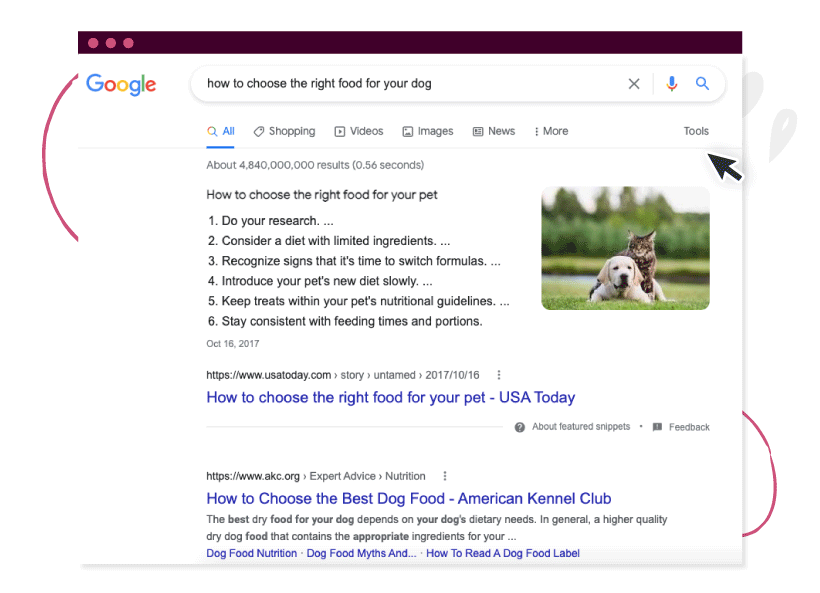Choosing the right pillar page topics should be an important part of your content planning and strategy.
Pillar content can attract more traffic, shares, and backlinks compared to shorter blog posts and articles — but only if you choose relevant topics.
And, sometimes, pillar pages become top content performers, especially when they’re regularly refreshed to stay accurate and current.
But how do you know which pillar page topics to choose and how to write a pillar page that works for both search engines and human searchers?
How to pick the right pillar page topics
Pillar pages generally take more effort and resources (and provide better results) compared to your average blog post, and you need the right research and strategy to help you choose topics wisely.
In this guide, we break down all the different elements of picking the right pillar page topics for your blog so you can power up your content marketing efforts with pillar pages that:
- Build trust and authority in your industry
- Enable you to link out to tons of other related content
- Engage customers, so they keep checking out your content and come back to your brand for future insights
Let’s dive in.
The topic ideation process for pillar pages
Your pillar page serves as a hub for various topic clusters, which are hyperlinked back to the broad overview of the topic you feature in the pillar page content.
Your SEO experts should provide keyword research that shows you which keywords are best for your business to target, and then you should create your pillar pages accordingly.
One thing to keep in mind is that Google’s ultimate focus is on improving the user experience for its searchers, so any pillar page content ideation process should include a focus on the customer’s pain points.
When you know their problems, you can provide relevant and useful information that leads, and customers are more likely to engage with.
1. Focus on the buyer’s journey
First, you want to understand your customer: their likes, their dislikes, what their typical day consists of, and what would motivate them to purchase your product. Create buyer personas that give you a clear view of each customer segment.
Then, map out the customer journey to understand what each buyer’s pain points are along the way and what solutions they’re searching for at each step of the journey.
What questions or terms are they searching for? What information do they need to make the decision to purchase your product or service?
You can use pillar pages to address pain points at every step of the buyer’s journey. From brand awareness to conversion, think about what blog topics are most likely to engage your target leads and customers based on what their needs are.
2. Identify broad topics
Pillar pages focus on a broad topic versus a specific topic/keyword, so the pillar page can link out to pieces of content that address more specific topics. Avoid choosing a pillar page topic that could be answered like a “yes” or “no” question. You’ll want a topic that has legs – in this case, those legs are your cluster topics.
However…don’t make your pillar page topics too broad. You want to address actual search queries, so a little bit of specificity will help.
For example, instead of choosing a pillar page to be about “pet food,” it would be better to make it about “how to choose the right food for your dog”. Topic clusters from that pillar page could be on topics like “vegetarian dog food,” “fresh vs. dry dog food” and “best dog food ingredients”.
3. Test your topic
Any good content strategy relies on keyword research. Start by exploring what pillar page topics you want to rank for in a search engine, based on which keywords are most likely to engage your target audience.
You should also be mindful of conversational search queries, as Google reports that 27% of the global online population uses voice search on mobile.
Your keyword research should account for both keywords that are typed in on a computer or mobile device, as well as keywords that are likely to be spoken into devices like smartwatches and phones.
For pillar page topics, you can type the exact topic you’re thinking of into Google’s search engine to see if there’s interest.
Using the pillar page topic example of “how to choose the right food for your dog,” you’ll find articles published by both major newspapers like “USA Today,” as well as reputable pet organizations like the American Kennel Club.
Pay attention to the “People also ask” section, which can give you ideas for subheads on your pillar page or standalone cluster topics. Using the above example, questions like, “What’s the healthiest food to feed your dog?” and “What type of food do vets recommend for dogs?” pop up.
You can also look at Google’s auto-populating keywords as you type an idea in. You’ll find “how to choose the right food for your puppy” is a suggested query when you type in “how to choose the right food for your dog”. The puppy topic could work as a subtopic for your pillar page.
4. Analyze your current content
As you develop your pillar page blog architecture, you’ll want to take an inventory of the content you’re already working with. You will want to avoid duplicate content in your pillar page strategy, so it’s helpful to do a content audit to see:
- What content you already have that relates to a pillar page topic
- Which high-performing content might make sense to convert to a pillar page
- What content you can incorporate into or link out to from a new pillar page topic
- What content you should consolidate into a pillar page and remove altogether
Your content audit will help you understand what your best-performing content is, so you know what topics you may want to create new pillar pages for.
Evaluate which of your existing content is most likely to generate leads or convert customers. Those topics may be worth focusing on in a more in-depth pillar page strategy.
If one of your existing pieces of content is already performing well for you, you can turn it into skyscraper content. This process involves “10x”-ing your content, which is to make the edited content piece 10 times better than any other content on the topic on the web.
How can you turn existing content into skyscraper content? An existing post can become a pillar page when you:
- Add content to it to make it longer than it already is, up to several thousand words per pillar page.
- Create a table of contents that features related hyperlinks to cluster topics in the beginning of the content.
- Update the content to ensure it’s accurate and provides even more value to your target leads and customer.
- Optimize existing content through keyword optimization, creative writing, or adding a free downloadable guide/tool to it.
You might be able to combine several of your existing posts into a single pillar page. Look for posts that are shorter and closely related that you could combine together.
5. Create goals for your pillar pages
To optimize your pillar page strategy going forward, you’ll want to set goals and measure key KPIs. Think about what specific business goals you want each pillar page to achieve, both short-term and long-term.
Involve teams beyond marketing in your pillar page strategies, such as your sales team or customer service team. These team members can provide you with topic ideas to research and content suggestions to build out for your pillar pages.
Continue to pay attention to what your customers are asking you and what they’re saying online. They can also help provide ideas for cluster topics for your existing pillar pages and for new pillar page ideas.
6. Measure, analyze, and add to your pillar pages
As you monitor your pillar page results, pay attention to which cluster topics are performing well. Is there content you can create that gets even more granular on those topics?
Continue to add new related links to your pillar pages. Since your pillar page has a lot of useful information and content linked within it, promote the pillar page link on sites like social media and in channels like email marketing. Make the cluster topic links prominent, so visitors can find the exact info they’re looking for from the pillar page.
Put yourself in your customers’ shoes
Pillar page content can help you generate more leads and convert more customers. Put yourself in your customers’ shoes and think about how your brand can help them solve their problems. Use keyword research to identify terms that have a high potential for conversion when can be used in a pillar page context.
Need help creating pillar pages or coming up with a pillar page topic strategy? Talk to a content specialist at ClearVoice today.







